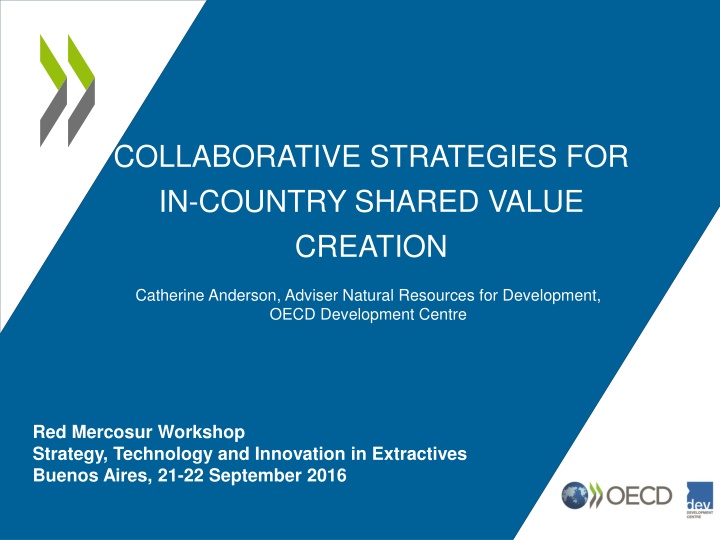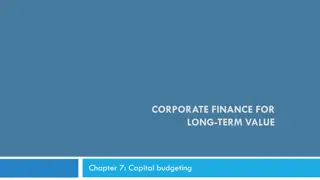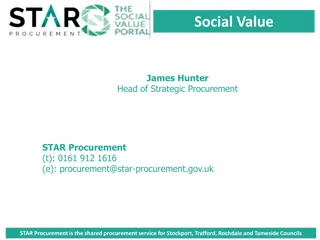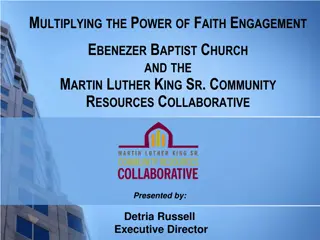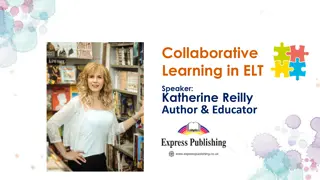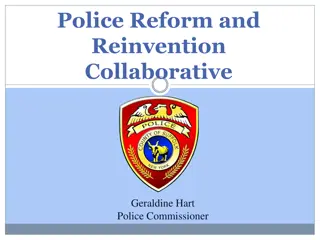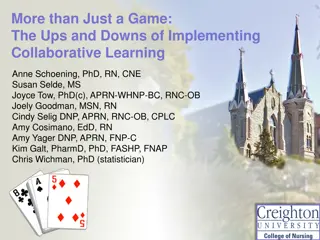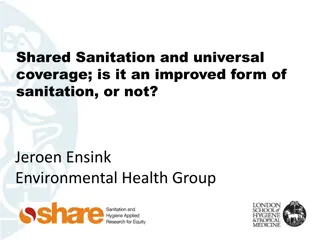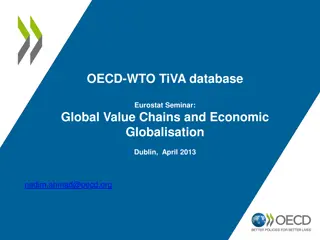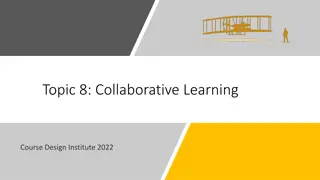Collaborative Strategies for Shared Value Creation
Policy dialogue on natural resource-based development open to producing countries/economies, maximizing benefits from extractives, framework on collaborative strategies for in-country shared value creation, and a five-step framework focusing on building competitive and diversified economies by creating shared value out of natural resources.
Download Presentation

Please find below an Image/Link to download the presentation.
The content on the website is provided AS IS for your information and personal use only. It may not be sold, licensed, or shared on other websites without obtaining consent from the author.If you encounter any issues during the download, it is possible that the publisher has removed the file from their server.
You are allowed to download the files provided on this website for personal or commercial use, subject to the condition that they are used lawfully. All files are the property of their respective owners.
The content on the website is provided AS IS for your information and personal use only. It may not be sold, licensed, or shared on other websites without obtaining consent from the author.
E N D
Presentation Transcript
COLLABORATIVE STRATEGIES FOR IN-COUNTRY SHARED VALUE CREATION Catherine Anderson, Adviser Natural Resources for Development, OECD Development Centre Red Mercosur Workshop Strategy, Technology and Innovation in Extractives Buenos Aires, 21-22 September 2016
Policy Dialogue on Natural Resource-based Development Open to any producing countries/economies, all participating on equal footing, regardless of their OECD or Development Centre s membership. 2
Maximising benefits of extractives Developing workable approaches and tools that respond to current economic climate in sector and are equitable. Managing public expectations generated by huge investment projects and perception that benefits not equally shared. Working with prevailing legal/regulatory obligations (WTO, BITS/RiTs) Enabling free and frank exchange of information and ideas. Catalysing sustainable benefits - is a long-term process which requires coordination within government and collaboration across different stakeholders. 3
Framework on Collaborative Strategies for In-Country Shared Value Creation http://dx.doi.org/10.1787/9789264257702-en t http://dx.doi.org/10.1787/9789264259409-fr). An operational tool with actionable steps to assist host governments and extractives industries to work together in a coherent way to realise shared value. A guide to understanding different roles and responsibilities and potential for creating shared value Dimensions of value include local employment, local procurement, shared used of infrastructure, power, transport and innovation. 4
Strategic Partnerships and Dialogue for Creating and Sharing Value Framework on Collaborative Strategies for In-Country Shared Value Creation: Extractive Projects Compendium of Practices Country Reviews 5
The Five-Step Framework Step 1:adopt a comprehensive long-term vision and implementation strategy to build competitive and diversified economies and create in-country shared value out of natural resources Step 2:build an empirical basis to inform decision-making through an inclusive participatory process Step 3: Unlock opportunities for in-country shared-value creation (local workforce and supplier development, shared infrastructure: water, power and transport) Step 4:Support and contribute to innovation leading to new products and services Step 5:Establish effective and transparent monitoring and evaluation systems and regularly review the collaborative strategy 6
Step 1: adopting a comprehensive long-term vision and implementation strategy to build competitive and diversified economies and create in-country shared value out of natural resources Host governments Extractive industries Look beyond project- and sector-specific opportunities to avoid dependence. Work to enable internal alignment, coordination, and policy coherence. Understand production and market structures and identify potential country positioning into regional and GVCs. Manage stakeholders expectations. Understand local dynamics and power structures in local communities Take a long-term approach. Identify areas for pre-competitive collaboration with industry peers and stakeholders (skills requirements and solutions to common environmental challenges). Build inclusive fora for continuous dialogue where consesnsus can be built. Forecast the necessary infrastructure and capacity that should be in place to achieve extraction Identify opportunities in which business activities can make a significant positive contribution 7
Step 2: build an empirical basis to inform decision- making through an inclusive participatory process Host governments Extractive industries Act as conveners, identify and engage stakeholders build information platforms Collect data on current and future needs of sector and its stakeholders, and its impacts (e.g. environmental) Identify segments with high growth potential Identify trade-offs and associated costs/ benefits Map economically viable links to domestic Provide disaggregated data to government on workforce demands, goods, services, infrastructure technologies and other inputs (land, water and energy) Articulate criteria for participation in extractives value chains (price, delivery reliability, safety, quality) and conformity (labour, environment etc) Examples: Total s baseline survey in Uganda Nigeria/Norway cooperation to assess potential for value creation in Nigeria Brazil s PROMINP national competitiveness diagnostic study WA s model of integration of aboriginals into the extractive value chain economic across the value chain (dynamic) Build information platforms to share knowledge/info and unlock potential multiplier effects. Map potential economic opportunities over the course of the project Identify barriers to entry Identify goods and services that are highly specialised or subject to strong competition 8
STEP 3.1 Unlocking opportunities for in-country shared- value creation (local workforce and supplier development, shared infrastructure: water, power and tranport) Host governments Extractive industries Focus on process / collaborative efforts rather than targets and penalties (e.g. Australia, Canada, Oman). Match training opportunities with industry demand in areas with high growth potential. Establish training funds for workforce and supplier skills development to which extractive companies can contribute. Develop and implement plans for progressive local workforce development and supplier participation Evaluate the potential to unbundle contracts, and make forward purchase agreements. Examples: Namibia s Petroleum Training and Education Fund, forward purchase agreements in Zambia, partnership between 5 banks in Nigeria to facilitate SMEs access to credit Collectively undertake a gap analysis assessing national education and training systems against current and future needs, with a view to align government plans and industry needs. Evaluate the time and resources needed to close any identified technological, infrastructure, capabilities, and financing gaps. Identify and prioritise quick wins. Collectively assess the capabilities of the available local workforce and supply base 9
STEP 3.2 Shared use of infrastructure: roads, railways, ports, access to power and water Host governments Extractive industries Outline anticipated demand for infrastructure and potential contributions to infrastructure building Identify any idle capacity in company infrastructure facilities that could be made available to other users Jointly develop infrastructure plans with government. Collaborate with other extractives companies from the same basin to invest in infrastructures for industrial and non- industrial use. Assess the feasibility of renewable energy power generation options Obtain extractive projects projections for infrastructure needs (transport, power, water) to allow for early planning and effective coordination among relevant central and local authorities Consider opportunities and scale of possible power-gas and/or power mining integration Allocate resources on competitive and equitable terms. Consider infrastructure use in the equilibrium of the overall contract Clearly articulate government and company responsibilities/liabilities for infrastructure development and maintenance. 10
Step 4 Innovation: Support and contribute to innovation leading to new products and services Ref: Chile Solar Host governments Extractive industries Identify changing trends in global consumption and production patterns, changes to end uses for minerals, and carbon emissions trading Consider trade-offs associated with technological innovation Support research and development to identify, adapt and transfer technology, develop ties with universities, public research initiatives, etc. Invest in specialised technologies with low environmental footprint Leverage the extracives sector operations to increase use of renewable energy (e.g. using green power or developing green supply chains) Contribute to improving the innovative capacity of subsidiaries and subcontractors Contribute to finding solutions to shared industry challenges Engage in cooperation based on life cycle analysis, covering the entire value chain and offering the opportunity to exploit best practices of several sectors. 11
STEP 5 Monitoring and evaluation and regular review: Host governments, industry and civil society Develop/integrate standardised yet flexible methodoloy and reporting procedures into local M&E systems to measure performance. Evaluate impact, including local industry participation over time, efficient use of limited resources and creation of value for all stakeholders involved Re-avaluate measurements from time-to-time and reveiw progress made in light of changes in the operating environment and lessons learned Inform each other on potential new constraints or changing circumstances Review progress in implementation of the strategy Discuss and agree on potential adjustments For industry share available data and information with host government. . 12
Next Steps Use the Framework as a reference for in-depth country/regional analysis; to identify viable opportunities for shared value creation and upgrading; and to address barriers. Collect concrete examples for a Compendium of Practices on how public-private collaboration can work in practice, showing what has and has not worked in different situations and offering good practice examples. Mobilise LAC engagement in PD through Red Sur or otherwise. OECD Development Centre : support the development of Strategies on Resource-based Value Creation for the implementation of the 2030 Sustainable Development Agenda. 13
More information WEBSITE: http://www.oecd.org/dev/natural-resources.htm CONTACT: Dr Lahra Liberti, Head of Natural Resources for Development Unit, OECD Development Centre lahra.liberti@oecd.org Catherine Anderson, Adviser, Natural Resources for Development Unit, OECD Development Centre Catherine.Anderson@oecd.org 14
